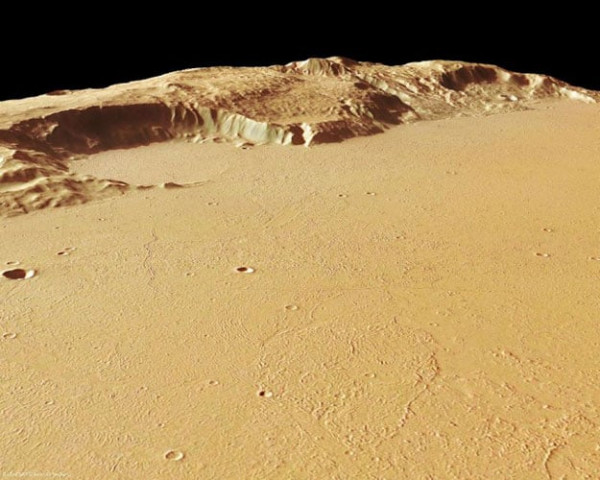Monster volcano gave Mars extreme makeover: study
Outcropping was so huge it caused Mars' top two layers to swivel around like skin and flesh of a peach

A high-resolution stereo camera-obtained image released on September 26, 2008 by the European Space Agency shows the Mangala Fossae trough, a system of outflow channels on Mars, that bears evidence of lava deposition and catastrophic floods PHOTO: AFP
Mars' original north and south poles, in other words, are no longer where they once were.
The findings explain the unexpected location of dry river beds and underground reservoirs of water ice, as well as other Martian mysteries that have long perplexed scientists, the lead researcher told AFP.
International Space Station's crew returns to Earth after one year
"If a similar shift happened on Earth, Paris would be in the Polar Circle," said Sylvain Bouley, a geomorphologist at Universite Paris-Sud.
"We'd see Northern Lights in France, and wine grapes would be grown in Sudan."
The volcanic upheaval, which lasted a couple of hundred million years, tilted the surface of Mars 20 to 25 degrees, according to the study.
The lava flow created a plateau called the Tharsis dome more than 5,000 square kilometres (2,000 square miles) wide and 12 km (7.5 mi) thick on a planet half the diameter of Earth.
"The Tharsis dome is enormous, especially in relation to the size of Mars. It's an aberration," Bouley said.
This outcropping -- upward of a billion billion tonnes in weight -- was so huge it caused Mars' top two layers, the crust and the mantle, to swivel around, like the skin and flesh of a peach shifting in relation to its pit.
Already in 2010, a theoretical study showed that if the Tharsis dome were removed from Mars, the planet would shift on its axis.
Bouley and colleagues matched these computer models with simulations and observations -- their own and those of other scientists.
Many things on Mars that begged explanation suddenly make sense in light of the new paradigm.
"Scientists couldn't figure out why the rivers" -- dry riverbeds today -- "were where they are. The positioning seemed arbitrary," Bouley told AFP.
Red planet: NASA to simulate growing potatoes on Mars in Peru
"But if you take into account the shift in the surface, they all line up on the same tropical band."
Likewise the huge underground reservoirs of frozen water ice that should be closer to the poles. Once upon a time, we now know, they were.
The new theory also explains why the Tharsis dome is situated on the "new" equator, exactly where it would need to be for the planet to regain its equilibrium.
The findings, published in Nature, likewise challenge the standard chronology which assumes the Red Planet's rivers were formed after the Tharsis dome.
Most of these ancient waterways would have flowed from the cratered highlands of the Red Planet's southern hemisphere to the low plains of the north even without the massive lava fields, the study concluded.
"But there are still a lot of unanswered questions," cautioned Bouley.
"Did the tilt cause the magnetic fields to shut down? Did it contribute to the disappearance of Mars' atmosphere, or cause the rivers to stop flowing? These are things we don't know yet."



















COMMENTS
Comments are moderated and generally will be posted if they are on-topic and not abusive.
For more information, please see our Comments FAQ